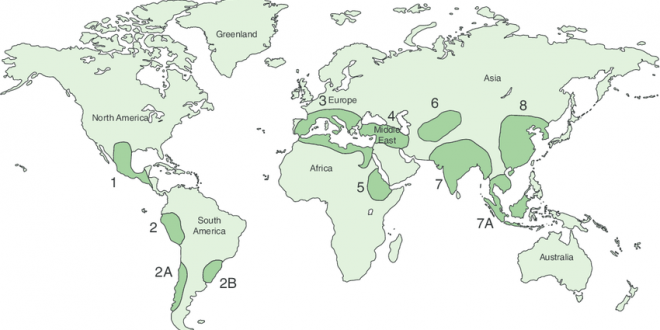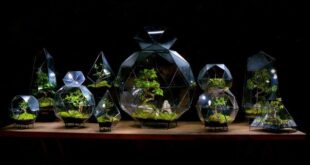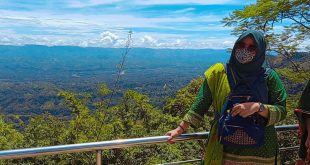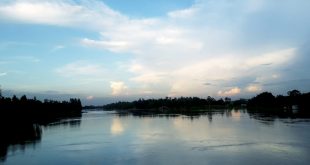Do you know what is Center of Origin?
The center of origin is a geographical area where the particular group of organisms (either domesticated or wild) first originated on earth.
This is the 2nd part of the topic: Concepts of center of origin of cultivated crops. If you have somehow missed the 1st part here is link to that article-
Vavilovian Centers of Origin
Nikolai Ivanovich Vavilov published his results in 1926 and developed a theory on the centres of origin of cultivated plants. He proposed 8 centres of origin of crop plants.
- South Mexican and Central American Center:
Includes southern sections of Mexico, Guatemala, Honduras and Costa Rica.
- Grains and Legumes: maize, common bean, lima bean, tepary bean, jack bean, grain amaranth.
- Melon Plants: malabar gourd, winter pumpkin, chayote.
- Fibre Plants: upland cotton, bourbon cotton, henequen (sisal).
- Miscellaneous: sweetpotato, arrowroot, pepper, papaya, guava, cashew, wild black cherry, chochenial, cherry tomato, cacao.
2. South American Center:
62 plants listed; three sub centers.
(2A) Peruvian, Ecuadorean, Bolivian Center:
- Root Tubers: Andean potato, other endemic cultivated potato species. Fourteen or more species with chromosome numbers varying from 24 to 60, Edible nasturtium.
- Grains and Legumes: starchy maize, lima bean, common bean.
- Root Tubers: edible canna, potato.
- Vegetable Crops: pepino, tomato, ground cherry, pumpkin, pepper.
- Fibre Plants: Egyptian cotton.
- Fruit and Miscellaneous: cocoa, passion flower, guava, heilborn, quinine tree, tobacco, cherimoya, coca.
(2B) Chiloe Center (Island near the coast of southern Chile)
- Common potato (48 chromosomes), Chilean strawberry.
(2C) Brazilian-Paraguayan Center
- manioc, peanut, rubber tree, pineapple, Brazil nut, cashew, Erva-mate, purple granadilla.
3. Mediterranean Center:
Includes the borders of the Mediterranean Sea. 84 listed plants.
- Cereals and Legumes: durum wheat, emmer, Polish wheat, spelt, Mediterranean oats, sand oats, canarygrass, grass pea, pea, lupine.
- Forage Plants: Egyptian clover, white clover, crimson clover, serradella.
- Oil and Fibre Plants: flax, rape, black mustard, olive.
- Vegetables: garden beet, cabbage, turnip, lettuce, asparagus, celery, chicory, parsnip, rhubarb.
- Ethereal Oil and Spice Plants: caraway, anise, thyme, peppermint, sage, hop.
4. Middle East:
Includes interior of Asia Minor, all of Transcaucasia, Iran, and the highlands of Turkmenistan. 83 species.
- Grains and Legumes: einkorn wheat, durum wheat, poulard wheat, common wheat, oriental wheat, Persian wheat, two-row barley, rye, Mediterranean oats, common oats, lentil, lupine.
- Forage Plants: alfalfa, Persian clover, fenugreek, vetch, hairy vetch.
- Fruits: fig, pomegranate, apple, pear, quince, cherry, hawthorn.
5. Abyssinian Center:
Includes Ethiopia, Eritrea, and part of Somalia. 38 species listed; rich in wheat and barley.
- Grains and Legumes: Abyssinian hard wheat, poulard wheat, emmer, Polish wheat, barley, grain sorghum, pearl millet, African millet, cowpea, flax, teff.
- Miscellaneous: sesame, castor bean, garden cress, coffee, okra, myrrh, indigo, enset.
6. Central Asiatic Center:
Includes Northwest India (Punjab, Northwest Frontier Provinces and Kashmir), Afghanistan, Tadjikistan, Uzbekistan, and western Tian-Shan. 43 plants.
- Grains and Legumes: common wheat, club wheat, shot wheat, peas, lentil, horse bean, chickpea, mung bean, mustard, flax, sesame.
- Fiber Plants: hemp, cotton.
- Vegetables: onion, garlic, spinach, carrot.
- Fruits: pistacio, pear, almond, grape, apple.
7. Indian Center:
Two sub centers.
(7A) Indo-Burma: Main Center (India): Includes Assam, Bangladesh and Burma, but not Northwest India, Punjab, nor Northwest Frontier Provinces, 117 plants.
- Cereals and Legumes: chickpea, pigeon pea, urd bean, mung bean, rice bean, cowpea.
- Vegetables and Tubers: eggplant, cucumber, radish, taro, yam Fruits: mango, tangerine, citron, tamarind Sugar.
- Oil and Fibre Plants: sugar cane, coconut palm, sesame, safflower, tree cotton, oriental cotton, jute, crotalaria, kenaf Spices, Stimulants, Dyes.
- Miscellaneous: hemp, black pepper, gum arabic, sandalwood, indigo, cinnamon tree, croton, bamboo, turmeric.
(7B) Siam-Malaya-Java: statt Indo-Malayan Center: Includes Indo-China and the Malay Archipelago, 55 plants.
- Cereals and Legumes: Job’s tears, velvet bean Fruits: pummelo, banana, breadfruit, mangosteen.
- Oil, Sugar, Spice, and Fibre Plants: candlenut, coconut palm, sugarcane, clove, nutmeg, black pepper, manila hemp.
8. Chinese Center:
A total of 136 endemic plants are listed in the largest independent center.
- Cereals and Legumes: g. rice broomcorn millet, Italian millet, Japanese barnyard millet, sorghum, buckwheat, hull-less barley, soybean, Adzuki bean, velvet bean.
- Roots, Tubers, and Vegetables: g. Chinese yam, radish, Chinese cabbage, onion, cucumber.
- Fruits and Nuts: g. pear, Chinese apple, peach, apricot, cherry, walnut, litchi, orange Sugar, Drug.
- Fibre Plants: g. sugar cane, opium poppy, ginseng camphor, hemp.
Limitations of Vavilov’s views
The expansion of our understanding on cultivated plants pointed certain limitations on Vavilov’s views. These views require some modifications.
- Vavilov considered the region with greatest genetic diversity of a species as the center of origin of that species. But now, many such species are known whose centers of origin and genetic diversity are different. For example, Maize and Tomato.
- The centers of origin of cultivated plants as per Vavilov are limited to the mountains and small hills in tropical and sub-tropical regions. But recent evidences also suggest plains as the centers of origin of many cultivated plants.
- Today several crops are known whose centers of origin are different from the ones suggested by Vavilov. Moreover there is more than one center of origin. Also, the origin of many of the species cannot be traced due to lack of sufficient evidence.
According to Vavilov primary center is marked by high frequency of dominant alleles towards the center and recessive towards the periphery. But this view is not acceptable as per the latest knowledge.
Reference: Wikipedia
 Plantlet The Blogging Platform of Department of Botany, University of Dhaka
Plantlet The Blogging Platform of Department of Botany, University of Dhaka





